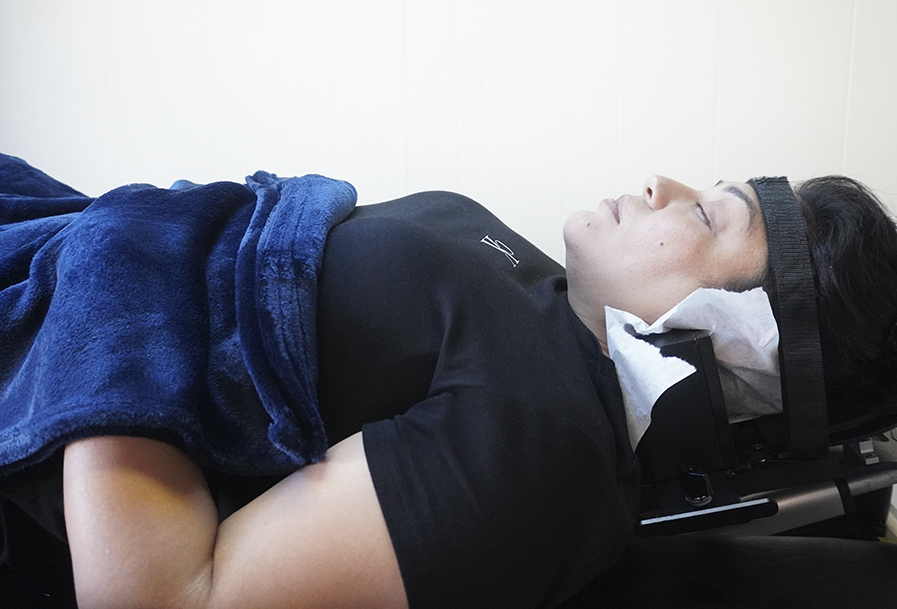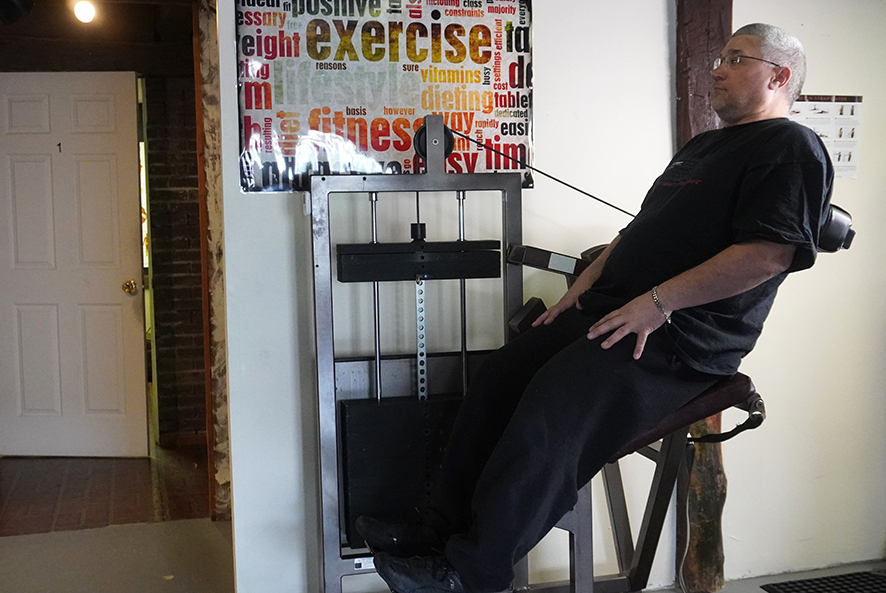Home > spinal decompression
Spinal Decompression
Non-surgical Spinal Decompression
Non-surgical Spinal Decompression- A Noninvasive approach to effectively treat lower back pain resulting from herniated or deteriorated discs. Spinal Decompression uses state of the art technology to apply a distraction force to relieve nerve compression that has been placed on spinal discs and nerves often associated with low back pain, sciatica, and even relapse or failed back surgery.
Non-surgical spinal decompression is a computer- controlled, advanced form of spinal decompression therapy that gently distracts the segments of the spine at precise angles. Compressed discs (also known as bulging, slipped, ruptured, prolapsed, or herniated discs) are the root cause of many issues that affect our bodies – not just the neck and back, but also arms, legs, and extremities. Decompressing these affected discs will allow healing, rehydration and restore nerve function.
What is spinal decompression?
Our Unique Technology Rises Above Other Spinal Decompression Options
At Fit Vida chiropractic and Disc Centers of America Reading, as a commitment to providing quality care for our patients, we provide the best decompression table available on the market (Accu-Spina). Accu-SPINA is the only therapeutic device approved to deliver IDD Therapy® (Intervertebral Differential Dynamics) Disc Treatment. IDD Therapy was developed in collaboration with top neurosurgeons, orthopedic surgeons, PTs, and other healthcare professionals, for the non-surgical resolution of back and neck pain. After decades of use, and millions of treatments, we are proud to say that IDD Therapy has maintained an exemplary safety record and outstanding
Benefits of Spinal Decompression
Non-surgical spinal decompression therapy offers several benefits over traditional surgical approaches. These include:
1. Non-Invasive:
Non-surgical spinal decompression therapy is a non-invasive procedure, which means that it does not require surgery or anesthesia. This reduces the risk of complications and shortens the recovery time.
2. Painless: Non-surgical spinal decompression therapy is a painless procedure that does not require any medication. Patients can relax and even fall asleep during treatment.
3. Quick: Non-surgical spinal decompression therapy typically takes only 20 to 30 minutes per session, and most
What Conditions Can Non-Surgical Spinal Decompression Therapy Treat?
Non-surgical spinal decompression therapy can be used to treat a variety of conditions that affect the spine, including:

A herniated disc occurs when the outer layer of a spinal disc tears, allowing the inner gel-like material to leak out. This can cause pressure on the surrounding nerves, resulting in pain and numbness. Non-surgical spinal decompression therapy can help to reposition the herniated disc, reducing pressure on the nerves and promoting natural healing.
A herniated disc occurs when the outer layer of a spinal disc tears, allowing the inner gel-like material to leak out. This can cause pressure on the surrounding nerves, resulting in pain and numbness. Non-surgical spinal decompression therapy can help to reposition the herniated disc, reducing pressure on the nerves and promoting natural healing.
A Noninvasive Way to Stop Back Pain
Back pain can be linked to any condition, but it’s easy to see how disruptive it can be if you’re forced to deal with it every day. You may not be able to participate in some of your favorite activities. If you want to escape back pain while avoiding invasive surgery, call our office today. Dr. Thomas Canseco will evaluate your condition and tell you if you are qualified for non-surgical spinal decompression.
If you want to escape back pain while avoiding invasive surgery, call our office today; Dr. Canseco will evaluate your condition and tell you if you qualify for non-surgical spinal decompression.

Aftercare instructions
You can do a few things at home to speed up your recovery and avoid relapse.
- Stay active: Exercise is important for a healthy back, but it’s important to avoid strain. Swimming and walking are good low-impact options.
- Maintain good posture: Good posture helps remove the strain from your back and spine.
- Quit smoking: Smoking can interfere with healing and increase your risk of relapse.
Manage your weight: Excess weight puts strain on your back. - Sleep on a firm mattress: A firm mattress supports your back and spine.
Recovery Timeline
Most people start to feel significant relief after the first few treatment sessions of spinal decompression in Reading, PA. The full effects of treatment may not be felt for a few weeks or even longer.
The longer you’ve been dealing with pain, the longer it will take to find relief. After a few weeks of treatment, you should start to feel better and have more energy.
You may also find that your pain only occurs occasionally instead of all the time. Sticking to your treatment plan is important, even if you feel better. Skipping treatment sessions can delay your full recovery.
Surgical Spinal Decompression vs Non- Surgical Spinal Decompression
When looking for solutions to back pain, you may consider spinal decompression surgery and non-surgical spinal decompression. Both are meant to help treat compressed nerves in the lower spine to relieve back pain, but a non-surgical approach is very different from a surgical one. Before deciding which treatment to pursue, we encourage you to think carefully about their differences.

Going back to your normal life
The exact timeline to recovery and start feeling better varies based on how healthy you are overall and your activity level during the treatment. However, since non-surgical spinal decompression is a noninvasive treatment, there is no recovery time to worry about. After every session, you can simply return to your normal daily routine; there is no need to set aside several days to recover. Dr. Canseco promotes physical rehabilitation in the third phase. Balance exercises , assisted stretches, and core strengthening exercises are typically part of the non-surgical decompression process.
Effectiveness
As a solution for back pain, back surgeries can have a failure rate as low as 10% or as high as 74%. Many patients find that the pain has decreased by around 50%, but very few experience total relief, and in many cases, the pain worsens again after just a few years. Considering the risks involved and how much time is spent on the surgical process, such uncertain odds of success may not be worth it unless you have no other choice. Non-surgical spinal decompression in Culver City, Van Nuys & Ontario provides an effective solution for back pain with much fewer risks.
Pain
As with any surgical procedure, there is soreness and discomfort associated with spinal decompression surgery. It can take up to 6 weeks to fade entirely, although the worst pain usually goes away after 4 weeks. With non-spinal decompression, there is no pain associated with the treatment itself, and there are few, if any, side effects. It may still take around 4 to 6 weeks to enjoy lasting relief, but you’re likely to see a reduction in pain sooner, and you can rest assured that the treatment won’t cause additional soreness.
Cost
As you can probably guess, non-surgical spinal decompression is generally less expensive than surgery, especially considering the time you’ll have to spend out of work. That said, you will have to take the benefits offered by your health insurance into account, as some procedures may or may not be covered under your plan. Our practice offers multiple payment plan options that can make spinal decompression more affordable, such as Care Credit, We also offer help with your insurance to maximize your benefits based on your treatment needs.

Understanding the Cost of Spinal Decompression
Before you commit to spinal decompression in Culver City, Van Nuys & Ontario, you’ll want to get a firm grasp of the costs involved. After all, stopping your pain is important, but so is managing your budget. We’ll give you an estimate of how much you can expect to pay for the treatment before we start the process, and we’ll also take the time to explain what options are available to make it as affordable as possible.
What are the factors for the cost of spinal decompression?
First, it’s important to remember that spinal decompression usually requires multiple sessions to get the best results. Some patients will need more sessions than others, so the final cost will largely depend on how many times you need to come into our office. Additionally, it should be noted that the cost of decompression can be different depending on what practice you go to. This is because different practices have different spinal decompression machines, and the more expensive machines often have a higher per-session cost.

Does Insurance Cover Spinal Decompression?
Spinal decompression in Culver City, Van Nuys & Ontario is indeed covered under most health insurance plans. This is not always the case, though, so before you call for an appointment, we recommend that you get in touch with your insurance carrier so that they can give you an outline of your benefits. If there’s anything you don’t understand about your coverage, our team is happy to help.
Financing available for these treatments
Spinal Decompression FAQs
How quickly do patients notice a reduction in pain?
Low back pain can have various causes, including:
Muscle or ligament strain: Overstretching or tearing of muscles or ligaments in the lower back due to sudden movements, lifting heavy objects improperly, or poor posture.
Herniated or bulging discs: Damage or rupture of the discs between the vertebrae, causing them to press on nerves and result in pain, numbness, or weakness in the lower back and legs.
Degenerative disc disease: Wear and tear on the discs over time, leading to loss of disc height, reduced flexibility, and potential nerve compression.
Spinal stenosis: Narrowing of the spinal canal, often due to aging, bone spurs, or other degenerative changes, resulting in pressure on the spinal cord and nerves, leading to pain, numbness, or weakness in the lower back and legs.
Osteoarthritis: Degeneration of the facet joints in the spine, leading to inflammation, stiffness, and pain in the lower back.
Skeletal irregularities: Conditions such as scoliosis or lordosis, which can cause misalignment of the spine and lead to back pain.
Traumatic injury: Accidents, falls, or sports injuries can cause fractures, sprains, or strains in the lower back, resulting in pain and discomfort.
Other factors: Obesity, poor posture, sedentary lifestyle, stress, and certain medical conditions like kidney stones or infections can also contribute to low back pain.
Identifying the specific cause of low back pain is crucial for developing an effective treatment plan tailored to the individual’s needs. Consulting with a healthcare professional is recommended for proper diagnosis and management.
Low back pain can have various causes, including:
- Muscle or ligament strain: Overstretching or tearing of muscles or ligaments in the lower back due to sudden movements, lifting heavy objects improperly, or poor posture.
- Herniated or bulging discs: Damage or rupture of the discs between the vertebrae, causing them to press on nerves and result in pain, numbness, or weakness in the lower back and legs.
- Degenerative disc disease: Wear and tear on the discs over time, leading to loss of disc height, reduced flexibility, and potential nerve compression.
- Spinal stenosis: Narrowing of the spinal canal, often due to aging, bone spurs, or other degenerative changes, resulting in pressure on the spinal cord and nerves, leading to pain, numbness, or weakness in the lower back and legs.
- Osteoarthritis: Degeneration of the facet joints in the spine, leading to inflammation, stiffness, and pain in the lower back.
- Skeletal irregularities: Conditions such as scoliosis or lordosis, which can cause misalignment of the spine and lead to back pain.
- Traumatic injury: Accidents, falls, or sports injuries can cause fractures, sprains, or strains in the lower back, resulting in pain and discomfort.
- Other factors: Obesity, poor posture, sedentary lifestyle, stress, and certain medical conditions like kidney stones or infections can also contribute to low back pain.
If you’re experiencing low back pain, consider seeking relief with Dr. Thomas Canseco, a skilled chiropractor. His expertise in spinal health and personalized treatment plans can help address the root cause of your pain and restore your quality of life. Don’t let low back pain hold you back – schedule a consultation with Dr. Canseco today and take the first step towards a pain-free back.
Spinal Decompression therapy utilizes specialized equipment to apply a gentle pulling force to the spine, creating negative pressure within the intervertebral discs. This negative pressure helps to retract herniated or bulging discs, reduce pressure on spinal nerves, and promote the influx of nutrients and oxygen into the affected area, facilitating healing.
The equipment used in Spinal Decompression therapy is designed to target specific levels of the spine. By customizing the treatment parameters such as angle, force, and duration, chiropractors like Dr. Thomas Canseco can precisely target the affected spinal segment, allowing for decompression at that specific level. This targeted approach ensures that the therapy addresses the underlying cause of your symptoms effectively and safely.
During a Spinal Decompression session, the equipment gently stretches the spine, creating space between the vertebrae. This separation helps to alleviate pressure on the discs and nerves, reduce inflammation, and improve spinal alignment. Over time and with consistent treatment, Spinal Decompression therapy can provide relief from symptoms associated with various spinal conditions, promoting overall spinal health and function.
Spinal decompression therapy is generally considered safe when performed by a qualified healthcare provider, such as Dr. Thomas Canseco, our chiropractor. However, as with any medical procedure, there are potential risks and considerations to be aware of:
1. Temporary soreness: Some patients may experience mild soreness or discomfort during or after Spinal decompression treatment, particularly in the treated area. This discomfort typically resolves quickly and can be managed with ice packs or mild pain medication if needed.
2. Rare side effects: While rare, there is a small risk of experiencing side effects such as muscle spasms, aggravation of existing symptoms, or allergic reactions to equipment components. However, these occurrences are uncommon and can often be mitigated with the proper adjustment of treatment parameters.
3. Contraindications: Spinal decompression therapy may not be suitable for individuals with certain medical conditions or risk factors, such as pregnancy, severe osteoporosis, spinal fractures, spinal implants, or certain neurological conditions. It’s essential to undergo a thorough evaluation with Dr. Canseco to determine if Spinal decompression is safe and appropriate for you.
4. Treatment limitations: While Spinal decompression can provide significant relief for many patients, it may not be effective for everyone or suitable for all spinal conditions. Dr. Canseco will assess your specific situation and recommend the most appropriate treatment options based on your needs and goals.
Overall, Spinal decompression therapy is considered a safe and effective, non-invasive treatment option for many individuals experiencing spinal conditions. Dr. Canseco will discuss any potential risks or concerns with you before starting treatment and ensure that your safety and comfort are prioritized throughout the process.
Spinal Decompression treatment and ordinary spinal traction share similarities in that they both involve the application of traction or pulling force to the spine. However, there are significant differences between the two therapies:
1. Targeted Approach: Spinal decompression treatment is typically more targeted and precise compared to ordinary spinal traction. It aims to specifically decompress and create negative pressure within the intervertebral discs, promoting the retraction of herniated or bulging discs, and reducing pressure on spinal nerves. This targeted approach allows for more effective treatment of specific spinal conditions.
2. Customized Parameters: Spinal decompression treatment often utilizes specialized equipment with adjustable parameters such as angle, force, and duration. These parameters can be customized by healthcare providers like Dr. Thomas Canseco to target specific levels of the spine and tailor the treatment to each patient’s individual needs and condition.
3. Controlled Decompression: Spinal decompression treatment typically involves a cyclical pattern of traction and relaxation, creating an intermittent pulling force on the spine. This controlled decompression helps to create space between the vertebrae, promote nutrient and oxygen exchange within the discs, and facilitate the body’s natural healing process.
4. Outcome Focus: Spinal decompression treatment is often focused on achieving specific therapeutic outcomes, such as reducing pain, improving spinal alignment, and promoting overall spinal health and function. While ordinary spinal traction may provide temporary relief from symptoms such as back pain or muscle tension, Spinal decompression treatment aims to address the underlying cause of spinal conditions and promote long-term healing and recovery.
Overall, Spinal Decompression treatment offers a more targeted, customized, and outcome-focused approach compared to ordinary spinal traction. Dr. Canseco can provide further information and guidance on which treatment option may be most suitable for your specific needs and condition.
Spinal Decompression treatment may be considered for patients who have previously undergone spinal surgery, depending on various factors such as the type of surgery, the specific spinal condition being treated, and the individual’s overall health and medical history. However, it’s essential to consult with a qualified healthcare provider like Dr. Thomas Canseco to determine if Spinal Decompression is appropriate in your particular case.
In some instances, Spinal Decompression therapy may be used as part of a comprehensive rehabilitation program following spinal surgery to help alleviate residual symptoms, promote healing, and improve spinal function. However, it’s crucial to ensure that the treatment is safe and compatible with any surgical hardware, fusion sites, or other considerations related to the previous surgery.
Dr. Canseco can conduct a thorough evaluation of your medical history, imaging studies, and current symptoms to determine if Spinal Decompression treatment is a suitable option for you after spinal surgery. Additionally, he can work collaboratively with your surgical team or other healthcare providers to ensure coordinated and comprehensive care. If you have had spinal surgery and are considering Spinal Decompression treatment, schedule a consultation with Dr. Canseco to discuss your individual situation and explore potential treatment options.
While Spinal Decompression therapy can be beneficial for many individuals with certain spinal conditions, it may not be suitable for everyone. Individuals who fall into the following categories may not be candidates for Spinal Decompression therapy:
1. Pregnant women: Spinal Decompression therapy involves the application of traction or pulling force to the spine, which may not be recommended during pregnancy due to potential risks to the developing fetus.
2. Severe osteoporosis: Individuals with severe osteoporosis, characterized by significant bone density loss, may have weakened bones that are more susceptible to fractures or injury during Spinal Decompression therapy.
3. Spinal fractures: Individuals with acute spinal fractures or unstable spinal conditions may not be candidates for Spinal Decompression therapy, as it could exacerbate the injury or compromise spinal stability.
4. Spinal implants: Patients with certain types of spinal implants, such as spinal fusion hardware or artificial discs, may not be suitable candidates for Spinal Decompression therapy due to potential interactions or limitations related to the implants.
5. Certain medical conditions: Individuals with certain medical conditions or contraindications, such as spinal tumors, infections, severe neurological deficits, or vascular disorders, may not be suitable candidates for Spinal Decompression therapy.
6. **Inability to tolerate treatment: Some individuals may not tolerate Spinal Decompression therapy well due to factors such as claustrophobia, anxiety, or discomfort with the treatment process.
It’s essential to undergo a thorough evaluation with a qualified healthcare provider like Dr. Thomas Canseco to determine if Spinal Decompression therapy is appropriate for your specific needs and condition. Dr. Canseco can assess your medical history, perform a physical examination, and review any relevant imaging studies to determine if you are a suitable candidate for Spinal Decompression therapy or if alternative treatment options may be more appropriate for you. If you have any concerns or questions about Spinal Decompression therapy candidacy, don’t hesitate to discuss them with Dr. Canseco during your consultation.
Candidates for Spinal Decompression therapy typically include individuals experiencing conditions such as:
1. Herniated discs: Patients with herniated or bulging discs causing nerve compression and associated symptoms such as sciatica or radiculopathy may benefit from Spinal Decompression therapy.
2. Degenerative disc disease: Individuals with degenerative changes in the spine, such as reduced disc height or disc degeneration, leading to symptoms like back pain or spinal instability, may find relief with Spinal Decompression therapy.
3. Sciatica: Patients experiencing sciatic nerve pain due to compression or irritation of the nerve roots in the lumbar spine may benefit from Spinal Decompression therapy to alleviate pressure on the nerves and reduce symptoms.
4. Spinal stenosis: Individuals with spinal stenosis, characterized by narrowing of the spinal canal and compression of the spinal cord or nerve roots, may find relief with Spinal Decompression therapy to create space within the spine and alleviate pressure on the affected structures.
5. Facet joint syndrome: Patients with facet joint syndrome, involving inflammation or degeneration of the small joints in the spine, may benefit from Spinal Decompression therapy to reduce pressure on the affected joints and alleviate associated symptoms.
6. Chronic low back pain: Individuals experiencing chronic low back pain that has not responded to conservative treatments such as medication or physical therapy may find relief with Spinal Decompression therapy to address underlying spinal issues and promote healing.
It’s essential to undergo a thorough evaluation with a qualified healthcare provider like Dr. Thomas Canseco to determine if you are a suitable candidate for Spinal Decompression therapy. Dr. Canseco can assess your medical history, perform a physical examination, and review any relevant imaging studies to determine if Spinal Decompression therapy is appropriate for your specific needs and condition. If you are experiencing symptoms related to any of the above conditions, schedule a consultation with Dr. Canseco to discuss your treatment options and determine if Spinal Decompression therapy is right for you.
Ready to take the next step?
Reclaim your health

